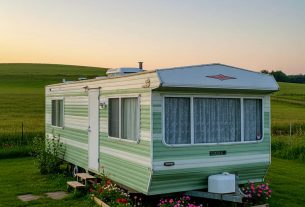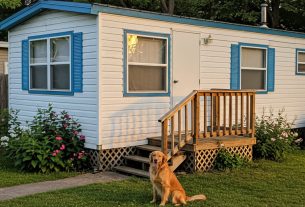As I sit here contemplating the evolution of housing, I find myself drawn to an often-overlooked aspect of American life: mobile homes. These structures, once considered mere temporary solutions, have transformed into a symbol of affordability and mobility. But when did mobile homes actually start? In this article, I will delve into the rich history of mobile homes, exploring their origins, development, and the socio-economic factors that shaped their journey. I’ll also share my thoughts on their contemporary relevance, and why they continue to be significant in our ever-changing world.
The Early Beginnings of Mobile Homes
The concept of portable housing isn’t new; it has roots that stretch back to the early 20th century. Initially, the term “mobile home” was synonymous with “trailer.” The first mobile homes can be traced back to the 1920s, when they were primarily used as travel trailers for vacationing families. These trailers were made from lightweight materials, allowing easy transport. But it wasn’t until the post-World War II boom that mobile homes began to take on a more permanent significance.
The 1940s: A Turning Point
As the war ended, America faced a housing crisis. Millions of returning soldiers needed homes, and traditional housing was in short supply. This period marked a pivotal moment for mobile homes. Manufacturers began producing larger, more durable models designed for longer-term living. The 1940s saw the introduction of the first “mobile homes,” which were essentially trailers designed for full-time living.
Key Features of Early Mobile Homes
- Lightweight Construction: Early models were made from aluminum and wood, which made them easy to transport.
- Modular Design: Many featured modular designs, allowing for customizations based on family needs.
- Affordability: These homes were relatively inexpensive compared to traditional housing, appealing to a wide demographic.
According to the Census Bureau, by the 1950s, mobile homes accounted for about 20% of new home sales in the United States. This statistic highlights the rapid acceptance and growth of mobile homes during this period.
The 1960s and 1970s: The Rise of the Mobile Home Industry
As the popularity of mobile homes soared, so did the industry surrounding them. Manufacturers began to streamline production, leading to improved quality and design. During the 1960s and 1970s, mobile homes became synonymous with affordable housing solutions for families struggling to find suitable living conditions.
Regulatory Changes and Standards
The growing popularity of mobile homes also led to the need for regulations. In 1976, the U.S. Department of Housing and Urban Development (HUD) established the first federal standards for mobile homes, which were aimed at ensuring safety, durability, and quality. This was a significant milestone that helped to legitimize mobile homes in the eyes of the public.
Key Features of Mobile Homes in This Era
- Increased Size: Mobile homes grew larger, with many now exceeding 1,000 square feet.
- Enhanced Amenities: Manufacturers began to include more features, such as modern kitchens and bathrooms.
- Community Development: Mobile home parks started to emerge, providing organized communities for residents.
By the late 1970s, mobile homes had become a staple of American housing, particularly in rural and suburban areas. The affordability and flexibility they offered were unmatched, making them a popular choice for many families.
The 1980s and 1990s: Changing Perceptions
As we moved into the 1980s and 1990s, the perception of mobile homes began to shift. While they continued to provide affordable housing, they also faced stigma and challenges. Many people viewed them as inferior to traditional homes, associating them with lower socio-economic status.
Innovations in Design and Construction
Despite the stigma, the industry continued to innovate. Manufacturers began to focus on aesthetics and quality, producing homes that were indistinguishable from traditional houses. This period saw the introduction of “manufactured homes,” a term that was meant to convey a higher standard of quality compared to mobile homes.
Key Features of Mobile Homes During This Time
- Higher Quality Materials: The use of better materials led to more durable and visually appealing homes.
- Energy Efficiency: Manufacturers introduced energy-efficient options, appealing to environmentally conscious consumers.
- Customization: Homebuyers were offered a range of customization options, from floor plans to finishes.
By the end of the 1990s, manufactured homes constituted a significant portion of the housing market, challenging the perception that they were merely a temporary solution.
The 2000s to Today: A New Era for Mobile Homes
As we entered the new millennium, mobile homes faced their greatest challenges yet. The housing crisis of 2008 had a profound impact on the entire real estate market, including manufactured homes. However, this adversity also paved the way for a renaissance in mobile housing.
The Impact of the 2008 Housing Crisis
During the recession, many people lost their homes, and the demand for affordable housing skyrocketed. Mobile homes emerged as a viable solution for displaced families. The appeal of affordable living in a quality-built home became more pronounced than ever.
Modern Trends in Mobile Homes
- Sustainability: The push for sustainable living has led to the increased popularity of eco-friendly mobile homes.
- Smart Technology: Many modern mobile homes come equipped with smart home technology, making them more appealing to tech-savvy buyers.
- Community Living: There’s a growing trend towards mobile home communities that foster a sense of belonging and support.
Today, the mobile home industry continues to thrive. Statistics show that over 22 million Americans live in manufactured homes, reflecting their growing acceptance and integration into the housing landscape.
Mobile Homes Around the World
While mobile homes are a significant part of American culture, they are not alone. Various forms of mobile housing exist worldwide, each with unique characteristics and histories.
Examples of Mobile Housing Globally
- Caravans in Europe: Much like American mobile homes, caravans serve as both temporary and permanent living solutions.
- Houseboats in Amsterdam: These floating homes offer a unique take on mobility and community living.
- Gypsy Caravans: Traditionally used by Romani people, these beautifully decorated homes represent a rich cultural heritage.
These global examples illustrate that the desire for mobility and flexibility in housing is a universal trend, transcending borders and cultures.
My Thoughts on the Future of Mobile Homes
As I reflect on the journey of mobile homes, I can’t help but feel optimistic about their future. The combination of affordability, flexibility, and evolving technology positions mobile homes to play a crucial role in addressing housing shortages and providing solutions for modern living.
Challenges Ahead
However, there are challenges that need to be addressed:
- Stigma: Overcoming the negative perceptions associated with mobile homes remains a significant hurdle.
- Regulatory Issues: Navigating zoning laws and regulations can be complex for prospective mobile homeowners.
- Financing: Accessing loans and financing options for mobile homes can be challenging compared to traditional homes.
By addressing these challenges and leveraging the opportunities that lie ahead, mobile homes can continue to evolve, providing affordable housing solutions for generations to come.
Conclusion
In conclusion, the history of mobile homes is a testament to the resilience and adaptability of human housing needs. From their humble beginnings in the 1920s to their status as a legitimate housing option today, mobile homes have come a long way. They represent not just a solution to housing crises but also a lifestyle choice that reflects a desire for freedom and flexibility.
As we look to the future, I believe that mobile homes will continue to play an essential role in shaping the housing landscape. They embody the spirit of innovation and adaptability, reminding us that home is not just a place but a feeling of belonging, no matter where life takes us.
Frequently Asked Questions
1. Are mobile homes a good investment?
Yes, mobile homes can be a good investment, especially in areas with high housing demand and limited inventory. They offer an affordable alternative to traditional homes and can appreciate in value over time.
2. How long do mobile homes last?
With proper maintenance, modern mobile homes can last for several decades. Many are designed to meet high standards of durability and quality.
3. Can I get a mortgage for a mobile home?
Yes, obtaining a mortgage for a mobile home is possible, though the process may differ from traditional homes. It’s advisable to shop around for lenders who specialize in manufactured home financing.
4. What are the differences between mobile homes and manufactured homes?
Mobile homes refer to homes built before 1976, while manufactured homes are built after that date and must meet HUD regulations. The term “manufactured home” is now preferred due to its association with higher standards of construction and design.
If you found this article insightful, I encourage you to share it with friends and on social media. Join our newsletter for more articles on housing trends and insights. Together, let’s continue the conversation about the future of living!
Liquified RV Toilet Treatment - Black Holding Tank Digester - Odor Eliminator - Orange Scent - Matts RV Reviews (Orange, 32oz)
$24.99 (as of November 16, 2025 07:53 GMT -03:00 - More infoProduct prices and availability are accurate as of the date/time indicated and are subject to change. Any price and availability information displayed on [relevant Amazon Site(s), as applicable] at the time of purchase will apply to the purchase of this product.)
Sign up for our newsletter and stay up to date with exclusive news
that can transform your routine!





